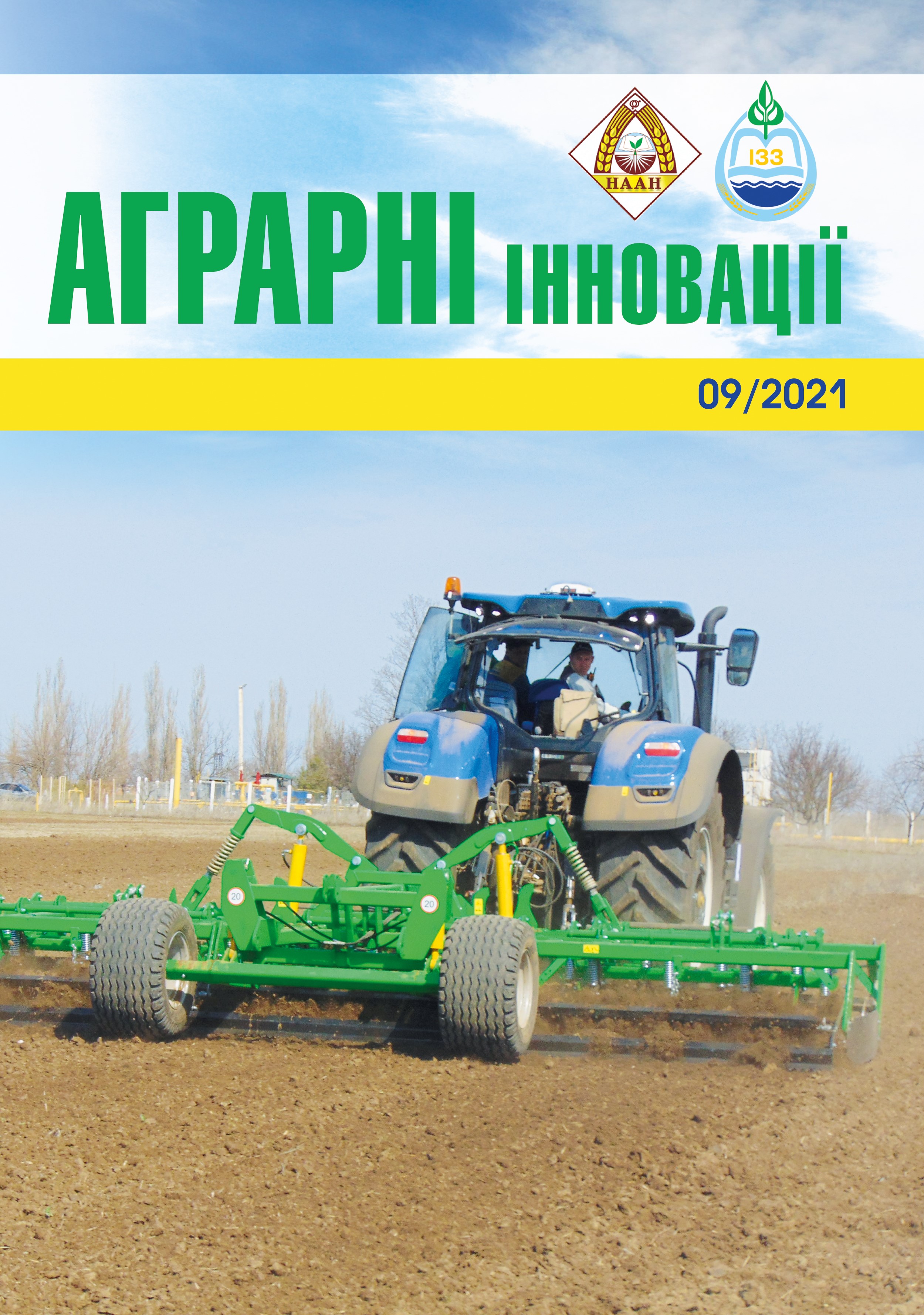Economic estimation of cultivation of lines of parent components and hybrids of corn of different groups of FAO in the conditions of the Southern Steppe of Ukraine
Abstract
Purpose. The aim is to establish an economic assessment of the cultivation of parental components and hybrids of maize of different FAO groups, to determine the cost-effectiveness of hybrids and parental components depending on the density of sowing and treatment with domestic biological products. Methods. The research was conducted during 2018–2020 on the research field of the Institute of Irrigated Agriculture of NAAS, located in the area of Ingulets irrigated massif. Factor A – different maturity lines – parental components and hybrids of different FAO groups, Factor B – plant density. Factor C – treatment with biological drugs. Results. The highest value of gross output per 1 ha was obtained on crops of the parent component line DK 445 at densities of 70 thousand units/ha and treatment with Helafit®-combi – 182.70 t/ha. In this case, the lowest cost of one ton of grain was also set. The cost of gross output per 1 ha at different densities and treatment with drugs was the maximum in the lines of the parent component of DC 445 and amounted to experimental variants from 119.19 to 182.70 thousand UAH/t, slightly less than the parent component in the parent component of DC 247 – 122.96 – 141.81 thousand UAH/t, less than the parent DC 411 – 114.55 – 133.11 thousand UAH/t, the lowest value of gross output was in the line DC 281 – 102.08 – 121.22 thousand UAH/t. The cost of gross output of hybrids of culture ranged in a very wide range: from 83.28 thousand UAH/ha in the hybrid Steppe in the control version without treatment with drugs for plant densities of 70 thousand plants/ha to 141.20 thousand UAH/ha in the hybrid Arabat using Helafit®-combi and plant density 70 thousand plants/ha. Conclusions. Given the production costs of growing corn, it should be noted that the most profitable and least expensive agricultural measure was such a factor as plant density. Due to the increase in corn grain yield and reduction of technological costs, the net profit is 61.86 – 138.19 thousand hryvnias per hectare. The highest conditionally net profit and profitability of the parent component of DC 281 for plant densities of 90 thousand/ ha and Helafit®-combi treatment – 79.83 thousand UAH/ ha and 193%, respectively. The highest conditionally net profit and profitability of the parent component of DK 247 for plant densities of 80 thousand /ha and Helafit®-combi treatment – 99.56 thousand UAH/ ha and 236%, respectively. The largest conditionally net profit and profitability in the line of DC 411 was for plant densities of 70 thousand/ha and Helafit®-combi treatment – 91.70 thousand UAH/ha and 212%, respectively. The highest conditionally net profit and profitability in the line of DK 445 for plant densities of 70 thousand/ha and Helafit®-combi treatment – 138.19 thousand UAH/ ha and 310%, respectively. At a density of 70 thousand plants/ha and treatment with Helafit®-combi on mediumlate hybrids, the rate of return was maximum – 373–375%.
References
2. Гойсюк Л.В., Гойсюк С.О. Оцінювання конкурентоспроможності кукурудзи на зерно та ріпаку сільськогосподарських підприємств України. Інноваційна економіка. http://www.inneco.org/index.php/innecoua/article/view/723/796 DOI: 10.37332/2309-1533.2021.1-2.12.
3. Грідін О.В. Сучасний стан та тенденції розвитку сфер виробництва, переробки та реалізації зерна: український та загальносвітовий контекст. Східна Європа: економіка, бізнес та управління. 2018.
№ 3(14). С. 54–62. URL: http://www.easterneuropeebm. in.ua/14-2018-ukr.
4. Дзюбецький Б.В., Черчель В.Ю., Антонюк С.П. Селекція кукурудзи. Генетика і селекція в Україні на межі тисячоліть. Київ : Логос, 2001. Т. 4. С. 571–589.
5. Амбросов В.Я. Питання конкурентоспроможності агроформувань. Вісник Харківського національного технічного університету сільського господарства: Економічні науки. 2009. Вип. 85. С. 3–9.
6. Рибка В.С., Шевченко М.С., Ляшенко Н.О. Стан виробництва зерна кукурудзи в Україні та програмне забезпечення її конкурентоспроможного розвитку на ближню перспективу. Эксклюзивные технологии. 2013. № 5. С. 12–18.
7. Шевченко М.С., Рибка В.С., Ляшенко Н.О. Основні аспекти забезпечення економічної стійкості виробництва зерна кукурудзи в Україні. Хранение и переработка зерна. 2014. № 6. С. 26–29.
8. Лавриненко Ю.О., Марченко Т.Ю., Забара П.П. Селекційні надбання та їх роль в стабілізації виробництва зерна кукурудзи в Україні. Зрошуване землеробство : міжвідомчий тематичний науковий збірник. Херсон : ОЛДІ-ПЛЮС, 2019. Вип. 72. С. 160–174. URL: http://doi.org/10.32848/0135-2369.2019.72.21.
9. Raisa Vozhehova, Tetyana Marchenko, Olena Piliarska, Yurii Lavrynenko, Nataliya Halchenko, Pavlo Lykhovyd. Grain corn product yield and gross value depending on the hybrids and application of biopreparations in the irrigated conditions. Scientific Papers Series Management, Economic Engineering in Agriculture and Rural Development. 2021. Vol. 21, Issue 4. С. 611–619. PRINT ISSN 2284-7995, E-ISSN 2285-3952.
10. Ушкаренко В.О., Нікішенко В.Л., Голобородько С.П., Коковіхін С. В. Дисперсійний і кореляційний аналіз результатів польових дослідів : монографія. Херсон : Айлант, 2009. 372 с.
11. Ушкаренко В.О., Вожегова Р.А., Голобородько С.П., Коковіхін С.В. Методика польового досліду (Зрошуване землеробство). Херсон : Грінь Д.С., 2014. 448 с.
12. Vozhehova R.A., Lavrynenko Y.O., Kokovikhin S.V., Lykhovyd P.V., Biliaeva I.M., Drobitko A.V., Nesterchuk V.V. Assessment of the CROPWAT 8.0 software reliability for evapotranspiration and crop water requirements calculations. Journal of Water and Land Development. Polish Academy of Sciences (PAN) in Warsaw. 2018. No. 39 (X–XII). P. 147–152. URL: http://www.itp.edu.pl/wydawnictwo/journal; http://www.degruyter.com/view/j/jwld DOI: 10.2478/jwld-2018-0070.






